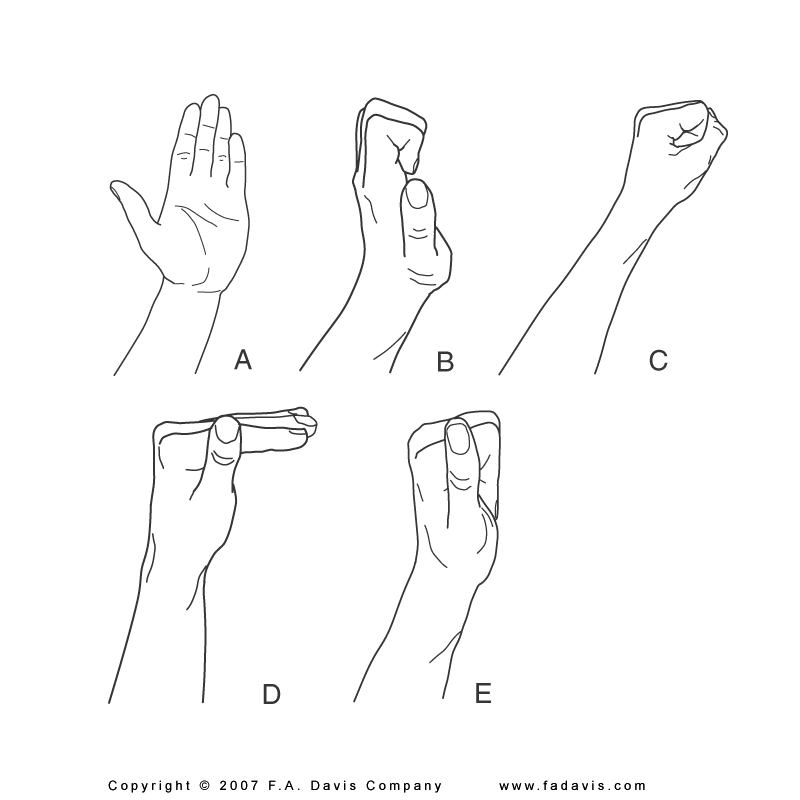Management of Wrist and Hand Conditions
Approaches in PT will depend largely on the level of acuity, pain, surgical precautions and restriction, and patient goals.
When treating a post-surgical patient (i.e. joint replacement, tendon repair, internal reduction), always observe ROM precautions and do not progress into active or active-assisted ROM activities until cleared by PT/MD.
Acute wrist and hand management principles:
- Immobilization
- attention to preserving maximum hand function and length tension relationships
- allowing repaired or replaced structures to rest according to post-operative guidelines and tissue healing principles
- FAILURE TO PROVIDE ADEQUATE PROTECTION TO INJURED STRUCTURES CAN RESULT IN COMPLETE TENDON AND/OR LIGAMENTOUS TEAR AND PERMANENT LOSS OF HAND FUNCTION
- Joint protection - Splinting
- custom or prefabricated splinting to allow for rest and tissue healing
- dynamic splints may be prescribed to allow for some motion in a limited range
- patient education in donn/doff, wear time, skin inspection, hygiene
- may include use of a platform attachment on crutch or FWW to allow continued ambulation while patient is NWB in the wrist
- Edema management - emphasis on relieving and reducing pressure to neurovascular structures to avoid secondary injury to surrounding nerves and tissue
- ace wrapping or compressive bandages
- contrast baths (hot/cold) for facilitating fluid reduction
- modalities
- instruction in positioning for edema management
- Soft tissue mobilization
- gentle scar mobilization and fascia mobilization for pain, swelling, and contracture management
- static stretching should precede friction massage to allow for creep of constrained soft tissue
- manual friction force is applied longitudinally to flexor tendons, both proximally and distally, while the tendons are on stretch
- Progressive early active motion (flexor tendon)
- Static, isometric exercises
- need MD clearance following any tendon or joint repair
- may need PT/PTA supervision to prevent inadvertent motion during muscle contraction
- "place and hold": patient is placed in position to challenge involved tendons and then is asked to "hold" the position
- ROM to uninvolved distal hand and proximal UE
- focus on maintaining ROM in unaffected joints and preventing secondary stiffness and weakness in shoulder, scapula, elbow, or forearm
- Activity modification
- instruction in alternative ways to lift, carry, dress, bathe, etc to allow affected wrist and hand structure sufficient protection for healing
- Coordination with OT
- in cases of significant hand trauma, patients may be referred to a certified hand therapist (CHT) for rehabilitation.
- Occupational therapy is likely to be involved to insure progressive return to function
- OTs fabricate and modify custom splints for the hand and can instruct in methods to modify grip to allow hand function without excessive stress to healing structures.
Subacute Wrist and Hand Management
- ROM with gentle stretching
- care with patients who have RA: no over stretching of involved joints
- Static isometric exercises - progress to different positions in the range
- Flexor Tendon-Gliding Exercises. The illustrated exercises below progressively challenge movement of the flexor tendons:
- Straight Hand
- Ape hand or claw hand
- Full fist
- Table top
- Straight fist
Return to Function
-
Progressive increased resistance and functional gripping activities
- Light resistance exercises train wrist stabilization during active finger motion for fine motor/manipulation tasks. Theraputic putty is available in varying degrees of stiffness to progressively strengthen instrinic hand muscles.
- Example how a patient might progress from early active motion - active motion - light resistance exercises for the hand ( 2 minute video
- Ergonomic assessment for injury/reinjury prevention
- Screen for future fall risk and coordinate recommendations with PT and health care team (e.g., considerations for home safety assessment)
Value: 5
Hand Return to Function
Active learning
- You will be tested on your ability to correctly describe precautions and stretches (stretch position and stretch selection)
- Perform strengthening exercises to reinforce your understanding of hand position and motions for specific muscle groups. For example, you should be able to correctly describe the point of manual resistance (i.e., dorsal, volar, etc) to activate muscles of the wrist and hand.
- Pertinent stretch and exercise material is found in Dutton, pages 557-564 (pay special attention to 564) and 579-581. You should also be able to identify where to apply appropriate resistance for general strengthening of flexors, extensors, radial deviators, etc.
